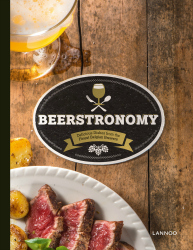The taste of a good pils according to Bart Durlet
Author: Erik Verdonck / Published: 2013-03-19 15:58:44 +0100 / Last Updated: over 8 years ago
 How should a good pils beer taste
How should a good pils beer taste© BeerTourism.com
TONGEREN - A cool glass of Pilsener beer. Massively popular, but do we know how it tastes or ought to taste? Brewer Bart Durlet, the man behind Tongeren’s local brew Amburon,
_798x1200.jpg?1363706728) Bart Durlet
Bart Durlet
© Erik Verdonck - BeerTourism.com
will be our guide.
Bart: “Pilsener quenches your thirst like no other beer, that’s why I would expect a bitter taste.
Take the new Maes, for example. This one is far maltier and contains more hops than the previous one, so it’s more bitter.
The brewer is after a subtle touch of bitterness, never acerbic, and a brief, dry aftertaste. Above all, a pils has to be pure, with just a short aftertaste and then a neutral mouth feel.
The ingredients of Pilsener are barley malts, with the possible addition of raw grains such as wheat, maize or rice, plus hops and yeast. It has to have these basic ingredients in abundance. However, quality ingredients do not always make for a good glass of Pilsener.
A well-drawn or poured pils is transparent. You can see straight away how well it has been filtered. Also, pils has a low alcohol content - 4.5% to 5.5% - so, as a brewer, you cannot hide your mistakes. If your Pilsener contains unwanted diacetyl, you cannot fail to notice it. It is important to drink your pils as freshly as possible from a cold glass.
Beer’s main enemies are oxygen, light, grease and heat. A freshly poured pils will go flat after only two minutes. Bart reckons it takes two minutes to empty a glass."
Draught Or Bottle?
The unanimous opinion is that it should be on draught. You get more volume, which slows down oxidisation and you don’t get a whiff of something strange you don’t want.
_798x1200.jpg?1363706677) © Erik Verdonck - BeerTourism.com
© Erik Verdonck - BeerTourism.com
Also, as a rule, draught beer is always fresher and younger. What exactly do you taste, and how do you go about it?
Tasting is observing. All beer tasting starts off with observation: examine the colour and the structure of the froth. How does the froth collapse and does it leave traces on the glass (side adhesion)?
Does it have the typical pilsner colour? Clarity also plays a major role. A well-filtered beer is clear. It is also of major importance that the beer is poured into a clean glass, which should be free of grease and fingerprints.
The next step is smell. There are hundreds of aromas to be found in beer. If you can smell bananas, this doesn’t always mean that banana has been used as an ingredient. For example, there are types of hops, which have a pronounced grapefruit aroma.
There is a near to endless range of aromas and flavours: pleasant flavours, from flowers, herbs and fruits to unpleasant smells such as musty, wet cardboard, rancid butter or ‘puttekesgeur’ (a drainy smell); all of which indicate mistakes made during brewing or fermentation.
The four basic tastes are sweet, sour, bitter and salt. Beer has all these flavours except for salt. You will find the other three in abundance and often combined! Unlike wine, beer has to be swallowed to taste it properly. The taste buds for bitter are at the back of the tongue; sour is on either side and sweet is at the tip of the tongue.
What To Look Out For?
“Learn to recognise what a brew should taste like so you can tell when it’s off. Consistency is a brewer’s main challenge, as his customers will expect the same beer with the same taste every time. This requires strict supervision of the brewing process. Smaller breweries rely on the nose for a final decision.”
First, Bart judges the beer’s appearance: colour, clarity, froth. He then lifts the glass up to his nose. A slight shake and turn of the glass will set free the aromas of the hidden ingredients. Then, he puts the glass to his mouth and takes a sip to savour the first taste impressions.
The rising temperature of the beer in the mouth, and the movement of the brew, will free up transient ingredients, which are observed through the taste buds in the mouth and the olfactory nose membranes. This allows Bart to judge the aromas. He then proceeds to research the aftertaste, the ‘mouth’, the carbon dioxide saturation.
And The Difference Is...
A blind pils tasting by the Belgian consumer association 'Test-Aankoop' (*) gave the highest rankings to Estaminet, Bockor and Maes. Bart is getting stuck into Maes, Jupiler,
_798x1200.jpg?1363706685) © Erik Verdonck - BeerTourism.com
© Erik Verdonck - BeerTourism.com
Estaminet, La Trappe Puur and Kaai Bier. I want to know if the beer is too warm. “No, it isn’t. For a tasting, I like a temperature around 10°C,” Bart declares.
“If the beer is too cold, you can’t taste anything.” The brewer pops open the bottle and listens. “Just hear the ‘ssssht’ made by the escaping carbon dioxide.
There shouldn’t be too much froth!” When pouring, he checks how the froth reacts, if there are pearly bubbles in the beer and also its clarity. Bart is now swirling the beer around in the glass.
He tucks his nose in and savours the aromas, which have now been freed. Bart: “Above all, I use my nose to taste. In this lot of Maes pils, I get unwanted aromas such as ‘paper’, ‘cardboard’, ‘metal’ or a ‘pasteurised’ taste.” Immediately, he points out the importance of storage.
Pils is best enjoyed at around three months; six months is about the limit at which you can keep it. This batch of Maes is unconvincing as the beer is not fresh enough. Jupiler is all things to all people, as it is malty, fruity and mild all at the same time. Bart detects a typical ‘grain aroma’ in this crystal clear and very fresh Pilsener.
.jpg?1363720804) © Erik Verdonck - BeerTourism.com
© Erik Verdonck - BeerTourism.com
Our beer taster is less complimentary when it comes to the Estaminet (Palm): “Mild, subtle, fruity but not enough bitterness for a pils. I won’t have a second one.”
Number four is the odd one out. La Trappe Puur is a pils from a Dutch Trappist brewery. Unlike our other Pilsners, this one is unfiltered. Cloudy flakes are dancing around. You have to pour this one slowly and carefully.
“A tasty pils with a lovely flower aroma, plenty of hops in the nose with a primarily dry bitterness. Great aftertaste,” is Bart’s opinion. La Trappe Puur is brewed with pure hops without using extracts.
We finish off our tasting with Kaaibier. This unfiltered pils is produced exclusively for brasserie De Bierkaai (www.bierkaai.be) in Heusden-Zolder. It is the only one of our five pilsners that continues to ferment in the bottle. Kaaibier is slightly fruitier and has a taste reminiscent of La Trappe Puur, with equally prominent hop flavours.
(*)Test-Aankoop issue, 557 Oktober 2011 tested 44 Pilseners.
Tongeren Blog Posts
 The Ambierorix beer festival in Tongeren parties for its 10th birthday
The Ambierorix beer festival in Tongeren parties for its 10th birthdayTONGEREN - "Am-bier-orix". Tongeren’s annual beer festival is the undisputed champion in the most difficult name competition. In Belgium we learnt about Tongeren at school. ... [ read more ]
 Time for Tongeren
Time for TongerenTONGEREN - This is one of the oldest cities in Belgium, with a history stretching back to the Romans. This short guide will introduce you to the must-sees of this fascinating city. As you approach ... [ read more ]
.jpg?1376908152) Anders Beer Festival: Small breweries and novel brews
Anders Beer Festival: Small breweries and novel brewsTONGEREN - Every year, under the approving gaze of the leader of the ancient Belgic tribe Ambiorix, Tongeren’s Grote Markt becomes one massive pub for one weekend in August. Around 30 brewers showcase ... [ read more ]
Comments
You must be logged in to leave a comment

You Might Like

Everything you ever wanted to know about (Belgian) beer under one roof. You get to feel, smell and taste ingredients and discover the typical Belgian beer styles. Come celebrate Belgian beer culture in heart of historic Bruges! Shop and bar are accessible without visiting the museum.

Kasteel Brouwerij Vanhonsebrouck, well known for it's "Kasteel" beer range, now offers their Bierkasteel beer experience; brewery visit, event location, restaurant, bar and shop.

Brasserie Dubussion prides itself on tradition and taste and has opened a brand new visitors centre, the Beerstorium. Learn about the rich history, beers and brewing at the oldest brewery in Wallonia. You can visit this authentic Belgian brewery, see brewing in action, as well as taste some of their delicious brews for yourself, including their legendary Bush (Scaldis) beer range.

The Duvel Moortgat Brewery caters to everyone’s tastes with 3 different brewery experiences. From complete novice to experienced beer lover, Duvel has the brewery visit package for you.
BLOG
POSTS
 Brussels Beer Challenge 2019, and the winners are...
Brussels Beer Challenge 2019, and the winners are...
BRUSSELS/MONS - We’ve made our way down to the historic city of Mons (Bergen) for the eighth edition of the international Brussels Beer Challenge. A 90-strong jury is busy tasting; there are four morning sessions in a ro... [ more ]
 Brugge Tripel contributes to renovation of Burgundian chapel of worship
Brugge Tripel contributes to renovation of Burgundian chapel of worship
BRUGES - This city draws you back in time to the heydays of the Burgundian era. After years of renovation works the Gruuthusemuseum has re-opened its doors. This former city palace is the showca... [ more ]
 Brewers of Europe Forum 2019: Craftsmanship on the old continent
Brewers of Europe Forum 2019: Craftsmanship on the old continent
ANTWERP - Brewers from 59 different countries flocked to attend the Brewers of Europe Forum 2019 in the prestigious Queen Elizabeth Hall, right next to the renowned Antwerp Central Station building. ... [ more ]
 Craftsmanship and balance at brewery Van Steenberge
Craftsmanship and balance at brewery Van Steenberge
ERTVELDE - To track down a brewer within his own domain is a high-ranking form of sports, or that’s the impression I get. After a bit of practice I spot Jef Versele, CEO of the Van Steenberge brewery, well hidden amongst... [ more ]
 Brussels Beer Challenge 2018 - The results!
Brussels Beer Challenge 2018 - The results!
MECHELEN - The historic city of Mechelen, halfway between Brussels and Antwerp, is truly a hidden gem. The presence of the Dukes of Burgundy, who ruled here in the late middle ages, still permeates the ancient city centr... [ more ]

More Beer
Pax Pils is a traditional pils that is popular in its local area. This beer was introduced in 1937, just a few years after the inauguration of the new Cornelissen brewhall. A b... [ more ]
Beer Tourism Newsletter Signup
Enter your name and email address on the right and click "SignUp" to join.









